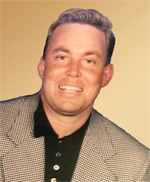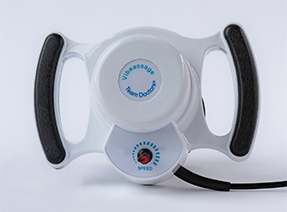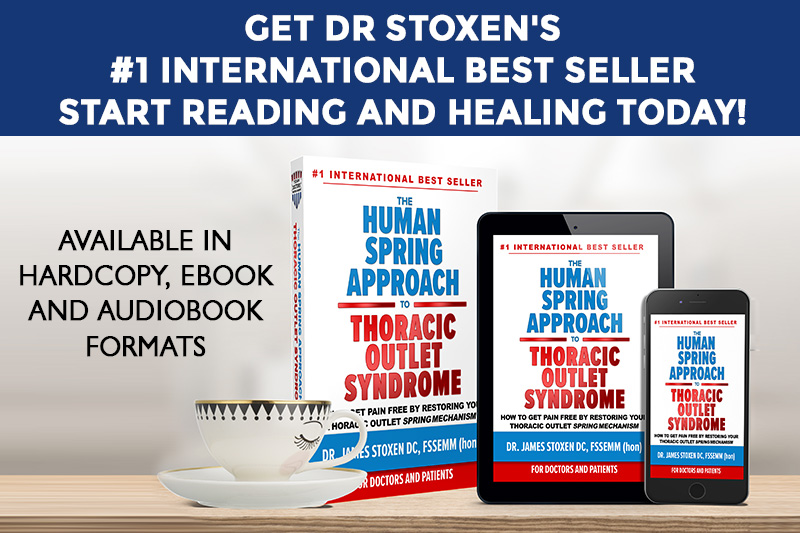THE HUMAN SPRING APPROACH TO
THORACIC OUTLET SYNDROME
by Dr James Stoxen DC., FSSEMM (hon) FWSSEM
GLOSSARY
P
Paget-Schroetter syndrome (Paget–von Schrötter disease Paget–Schroetter disease) – a form of upper extremity deep vein thrombosis (DVT), a medical condition in which blood clots form in the deep veins of the arms. These DVTs typically occur in the axillary or subclavian veins.
pallor – an unhealthy pale appearance.
palpation – examine (a part of the body) by touch, especially for medical purposes.
pancoast tumor (pulmonary sulcus tumor, superior sulcus tumor) – a type of lung cancer defined primarily by its location situated at the top end of either the right or left lung.
paralysis – the loss of the ability to move (and sometimes to feel anything) in part or most of the body, typically as a result of illness, poison, or injury.
paramedic – a healthcare professional, predominantly in the pre-hospital and out-of-hospital environment, and working mainly as part of emergency medical services, such as on an ambulance.
paresthesias – pins and needles (paraesthesia) is a pricking, burning, tingling or numbing sensation that’s usually felt in the arms, legs, hands or feet.
Parkinson’s disorder (disease) – a long-term degenerative disorder of the central nervous system that mainly affects the motor system. … Early in the disease, the most obvious are shaking, rigidity, slowness of movement, and difficulty with walking.
paroxetine (Paxil, Paroxetine, and Seroxat, among others) is an antidepressant drug of the selective serotonin reuptake inhibitor SSRI type.
passive elevation – when your body parts elevate without your muscles working. Someone else elevates them for you as in Cyriax Test.
passive muscle tone – tone or tension without a voluntary contraction of the muscle.
pathologic spring tension – When the nervous system creates an abnormal amount of tension on the spring that leads to inability for the spring to function to its maximum potential or lead to plastic deformity or spring failure.
pathophysiologic mechanisms – the functional changes associated with or resulting from disease or injury.
pectoralis minor tenotomy – surgical removal of the pedtoralis minor muscle to decompress the thoracic outlet.
percutaneous angioplasty – a surgical technique of mechanically widening narrowed or obstructed arteries by either vascular bypass or angioplasty are the two primary means of revascularization.
percutaneous revascularization – a surgical technique of mechanically widening narrowed or obstructed arteries by either vascular bypass or angioplasty are the two primary means of revascularization.
peripheral artery disease (PAD) – a condition of the blood vessels. It leads to narrowing and hardening of the arteries.
peripheral nerve compression (Nerve compression syndrome or compression neuropathy, entrapment neuropathy) a medical condition caused by direct pressure on a single nerve.
peripheral neuropathy – is a disease characterized by pain or loss of function in the nerves that carry signals to and from the brain and spinal cord to other parts of the body.
permanent deformity – a deformity that cannot be reversed.
perpendicular – at an angle of 90° to a given line, plane, or surface.
personal trainer – a person who works one-on-one with a client to plan or implement an exercise or fitness regimen.
PH – measures how acidic it is (pH stands for potential hydrogen, referring to how much hydrogen is mixed with the water.) 7 is a balanced pH for water. Anything below 7 indicates the water is acidic, and if it’s above 7 it is alkaline. … This is important because the human body has a natural pH of 7.4.
pharmacologist – One that studies the science of drugs including their characteristics, properties, uses and effects of a drug, especially those that make it medically effective.
phlebography – radiography of the veins carried out after injection of a radiopaque substance.
phlebography (venography, ascending phlebography) – radiography of a vein after injection of a radiopaque fluid.
phrenic nerve dysfunction – the phrenic nerve is a nerve that originates in the neck (C3-C5) and passes down between the lung and heart to reach the diaphragm. It is important for breathing, as it passes motor information to the diaphragm and receives sensory information from it. There are two phrenic nerves, a left and a right one. When the phrenic nerve is cut it will cause difficulty breathing.
phrenic nerve injury – an injury of the phrenic nerve
phrenic nerve paralysis – the phrenic nerve is a nerve that originates in the neck (C3-C5) and passes down between the lung and heart to reach the diaphragm. It is important for breathing, as it passes motor information to the diaphragm and receives sensory information from it. There are two phrenic nerves, a left and a right one. When the phrenic nerve is cut it will cause difficulty breathing.
Physical Therapists (PT) rehabilitation professional who promote optimal health and functional independence through the application of scientific principles to prevent, identify, assess, correct, or alleviate acute or chronic movement dysfunction, physical disability, or pain.
physical therapy – the treatment of disease, injury, or deformity by physical methods such as massage, heat treatment, and exercise rather than by drugs or surgery.
physical therapy for tos thoracic outlet syndrome – physical therapy focuses mainly on patient education, pain control, vibration therapy, manual therapy, range of motion, strengthening and stretching.
physicist – an expert in or student of physics.
physiologist – an expert in or student of the branch of biology that deals with the normal functions of living organisms and their parts.
physiology – the way in which a living organism or bodily part functions.
physiotherapy – British term for physical therapy.
pinched nerve – when too much pressure is applied to a nerve by surrounding tissues, such as bones, cartilage, muscles or tendons.
pinched nerve in neck symptoms – neck pinched nerve occurs when too much pressure is applied to a nerve in the neck by surrounding tissues, such as bones, cartilage, muscles or tendons. The symptoms are radiating pain, numbness, tingling and sometimes weakness.
pitting edema – swelling of body tissues due to fluid accumulation that may be demonstrated by applying pressure to the swollen area (such as by depressing the skin with a finger). If the pressing causes an indentation that persists for some time after the release of the pressure, the edema is referred to as pitting edema.
plantar fasciitis – inflammation of the plantar fascia, the bowstring-like tissue that stretches from the heel bone to the base of the toes. Plantar fasciitis can be due to calcaneal spurs, which typically cause localized tenderness and pain that is made worse by stepping down on the heel.
plastic deformity a permanent deformation or change in shape of a solid body without fracture under the action of a sustained force.
plethysmogram – an instrument for measuring changes in volume within an organ or whole body (usually resulting from fluctuations in the amount of blood or air it contains).
plethysmography – an instrument for recording and measuring variation in the volume of a part of the body, especially as caused by changes in blood pressure.
pleura – each of a pair of serous membranes lining the thorax and enveloping the lungs in humans and other mammals.
pleural effusion – excess fluid around the lung
plumb line – a vertical line (as of cord) directed to the center of gravity of the earth, that has at one end a weight (as a plumb bob) and is used especially to determine verticality or perpendicularity.
plyometric training – exercises in which muscles exert maximum force in short intervals of time, with the goal of increasing power (speed-strength). This training focuses on learning to move from a muscle extension to a contraction in a rapid or “explosive” manner, such as in specialized repeated jumping.
plyometrics – a free body movement exercise system using no weights or machines, but emphasizing calisthenics and repeated movements such as jumping high off the ground
pneumothorax – the presence of air or gas in the cavity between the lungs and the chest wall, causing collapse of the lung.
polymyalgia rheumatica – a disorder of the connective tissue characterized by pain and stiffness of the muscles, often occurring in association with temporal arteritis
positive engrams – healthy synaptic patterns in the nervous system movement patterns.
positron emission tomography (PET) (magnetic resonance venography MV, Venous Scintillation Scans) – a painless exam that uses high-frequency sound waves (ultrasound) to capture images of internal views of veins that return blood to the heart.
post-concussion syndrome PCS – the persistence of concussion symptoms beyond the normal two-month course of recovery.
posterior thoracic nerve (external respiratory nerve of Bell, thorasicus longus nerve, long thoracic nerve) – the nerve that supplies the serratus anterior muscle. This nerve is susceptible to damage during surgery to decompress the thoracic outlet. If it gets cut it may result in winging of the scapula.
postoperative bleeding or wound hematoma (associated with excessive anticoagulation) (hematoma is a bruise).
postoperative hemorrhaging – post-operative bleeding that can occur after any surgical procedure.
postural challenges – difficulty maintaining a healthy posture.
postural control – a complex skill based on the inter- action of dynamic sensorimotor processes. The two main functional goals of postural behavior are postural orientation and postural equilibrium.
postural equilibrium – the coordination of movement strategies to stabilize the center of body mass during both self-initiated and externally triggered disturbances of stability.
postural orientation – involves the active alignment of the trunk and head with respect to gravity, support surfaces, the visual surround and internal references.
postural sway – move or cause to move away from the center of gravity, slowly or rhythmically backward and forward or from side to side even when a person is standing still.
posture – the optimum position to be in to work with Earth’s gravity, where the least strain is placed on supporting muscles, while maintaining your head perpendicular to the pull of Earth’s gravity and the eyes level with the horizon.
practitioner – a person actively engaged in an art, discipline, or profession, especially medicine.
preload – something loaded or applied as a load beforehand.
prescription drug – a drug that can be dispensed only upon presentation of a legally valid prescription.
pressure points – a point on the body that when pressed causes pain.
pressure ulcers (bedsores, decubitus ulcers) — are injuries to skin and underlying tissue resulting from prolonged pressure on the skin. Bedsores most often develop on skin that covers bony areas of the body, such as the heels, ankles, hips and tailbone.
preventive medicine – preventive medicine is the specialty of medical practice that focuses on the health of individuals, communities, and defined populations. Its goal is to protect, promote, and maintain health and well being and to prevent disease, disability, and death.
procedural morbidity – the quality or state of being morbid; especially an attitude, quality, or state of mind marked by excessive gloom.
prominence – something that bulges out or is protuberant or projects from its surroundings.
proprioception – the ability to sense stimuli arising within the body regarding position, motion, and equilibrium.
prostaglandins – a group of physiologically active lipid compounds having diverse hormone-like effects in animals.
protective reflexes (protective response) – the reflexive withdrawal of the body or parts of the body from either actual or perceived painful stimuli.
provisional diagnosis – a medical diagnosis by a professional based on the information provided at the moment. A doctor issues a provisional diagnosis when first presented with a case and further tests or information are required before an exact diagnosis can be determined.
PSS (Paget Schroetter Syndrome) – Paget Schroetter syndrome refers to a blood clot that has development in the vein under the collarbone (subclavian vein).
pulmonary embolism – describes the blockage of a pulmonary artery or one of its branches by a blood clot or foreign material which has originated in a vein of the leg or pelvis and traveled to the lungs and that is marked by labored breathing.
pulmonary infarction (lung infarction) – occurs when a section of lung tissue dies because its blood supply has become blocked.
pulmonary sulcus tumor – (pancoast tumor, superior sulcus tumor) – a type of lung cancer defined primarily by its location situated at the top end of either the right or left lung.
pulse oximeter – a device that measures the oxygen saturation of arterial blood in a subject by utilizing a sensor attached typically to a finger, toe, or ear to determine the percentage of oxyhemoglobin in blood pulsating through a network of capillaries.
pulse oximetry – to measure the oxygen saturation of arterial blood with a sensor attached to a finger, toe or ear.

Meet Dr James Stoxen DC., FSSEMM (hon)
President, Team Doctors® Masters Academy
www.drstoxen.com
Dr Stoxen’s Curriculum Vitae
Stay connected to our thoracic outlet syndrome social media sites
1.1k
Members

READ THESE CHAPTERS OF DR STOXENS BOOK FREE HERE!
ARTICLE CATEGORIES
- Testimonials (13)
- Success Stories (13)
- Failed TOS Surgery (1)
- Thoracic Outlet Syndrome (11)
- Compartment Syndrome – Forearm (5)
- Shoulder Replacement Surgery (1)
- Cervical Discectomy (1)
- Cervical Fusion Surgery (1)
- What is TOS? (3)
- Thoracic Outlet Anatomy (1)
- Thoracic Outlet Engineering (1)
- Causes Of TOS (6)
- The TOS Examination (1)
- Diagnostic Tests for TOS (1)
- What Mimics TOS? (1)
- Paget-Schroetter Syndrome (2)
- TOS Surgery (2)
- Posture Tips (1)
- Self Treatment (1)
- What doesn’t work and why? (1)
- What works and why? (1)
- Stretches for TOS (1)
- Exercises for TOS (1)
- Surgery for TOS (1)
- Case Studies (2)
- Chapter Reviews (10)
- Uncategorized (16)
VIDEO TUTORIALS
Subscribe to our newsletter
Team Doctors® Master’s Academy
Professional Development Courses
Launching January 1, 2022!
Team Doctors® Master’s Academy
Patient Self-Care Workshops
Launching January 1, 2022!


















